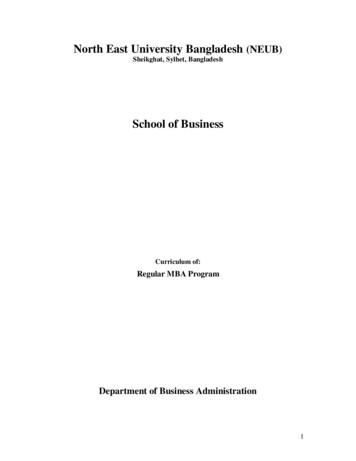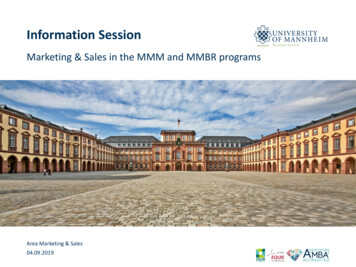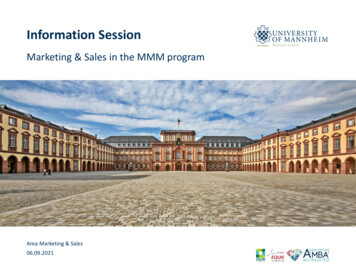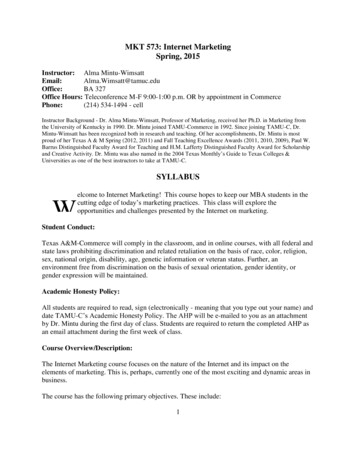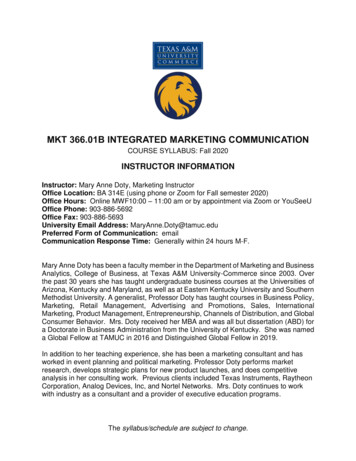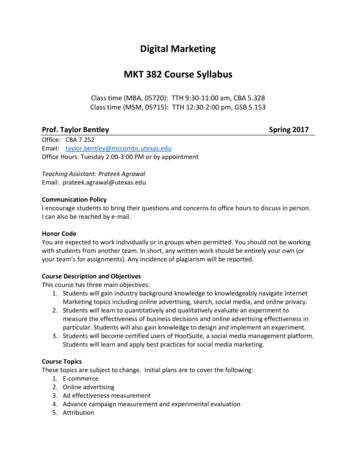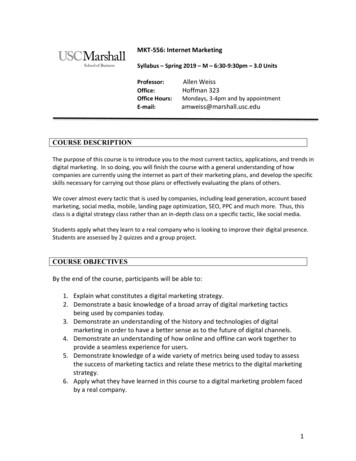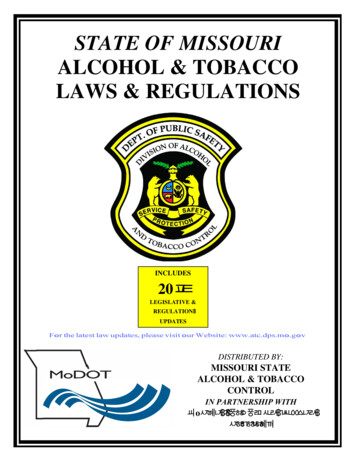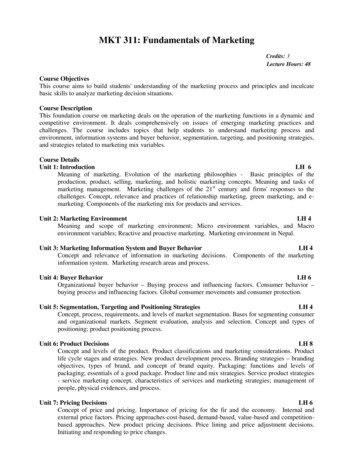
Transcription
MKT 311: Fundamentals of MarketingCredits: 3Lecture Hours: 48Course ObjectivesThis course aims to build students' understanding of the marketing process and principles and inculcatebasic skills to analyze marketing decision situations.Course DescriptionThis foundation course on marketing deals on the operation of the marketing functions in a dynamic andcompetitive environment. It deals comprehensively on issues of emerging marketing practices andchallenges. The course includes topics that help students to understand marketing process andenvironment, information systems and buyer behavior, segmentation, targeting, and positioning strategies,and strategies related to marketing mix variables.Course DetailsUnit 1: IntroductionLH 6Meaning of marketing. Evolution of the marketing philosophies - Basic principles of theproduction, product, selling, marketing, and holistic marketing concepts. Meaning and tasks ofmarketing management. Marketing challenges of the 21st century and firms' responses to thechallenges. Concept, relevance and practices of relationship marketing, green marketing, and emarketing. Components of the marketing mix for products and services.Unit 2: Marketing EnvironmentLH 4Meaning and scope of marketing environment; Micro environment variables, and Macroenvironment variables; Reactive and proactive marketing. Marketing environment in Nepal.Unit 3: Marketing Information System and Buyer BehaviorLH 4Concept and relevance of information in marketing decisions. Components of the marketinginformation system. Marketing research areas and process.Unit 4: Buyer BehaviorLH 6Organizational buyer behavior – Buying process and influencing factors. Consumer behavior –buying process and influencing factors. Global consumer movements and consumer protection.Unit 5: Segmentation, Targeting and Positioning StrategiesLH 4Concept, process, requirements, and levels of market segmentation. Bases for segmenting consumerand organizational markets. Segment evaluation, analysis and selection. Concept and types ofpositioning; product positioning process.Unit 6: Product DecisionsLH 8Concept and levels of the product. Product classifications and marketing considerations. Productlife cycle stages and strategies. New product development process. Branding strategies – brandingobjectives, types of brand, and concept of brand equity. Packaging: functions and levels ofpackaging; essentials of a good package. Product line and mix strategies. Service product strategies- service marketing concept, characteristics of services and marketing strategies; management ofpeople, physical evidences, and process.Unit 7: Pricing DecisionsLH 6Concept of price and pricing. Importance of pricing for the fir and the economy. Internal andexternal price factors. Pricing approaches-cost-based, demand-based, value-based and competitionbased approaches. New product pricing decisions. Price lining and price adjustment decisions.Initiating and responding to price changes.
Unit 8: Distribution DecisionsLH 4Concept and objectives of distribution. Channel functions and flows. Channel designs for consumerand industrial products. Channel selection factors. Channel conflicts and their resolution. Concept,nature and objectives of marketing logistics. Major logistics functions -transportation, warehousing,inventory management, order processing, and customer services decisions.Unit 9: Promotion DecisionsLH 6Concept and objectives of promotion. Marketing communication process and systems. Promotionmix components. Promotion mix determination factors. Advertising: Nature and objectives. Natureand relevance of personal selling. Nature and objectives of sales promotions. Sales promotion toolsand techniques. Nature, objectives and tools of public relations. Concept , relevance and methods ofdirect marketing.Basic TextsKotler, Philip, Gary Armstrong, Prafulla Agnihotri and Ehsan ul Haque. Principles of Marketing: SouthAsian Perspective. Prentice Hall of India, New Delhi, India.Baines, Paul, Chris Fill and Kelly Page. Essentials of Marketing. Oxford University Press, NewDelhi,India.ReferencesKoirala, K.D. Fundamentals of Marketing, M.K. Publishers and Distributors, Kathmandu, Nepal.Kamarulzaman, Yusniza and Nor Khalidah Abu. Principles of Marketing, Oxford University Press, NewDelhi, India.
MGT 314: Legal Environment of BusinessCredits: 3Lecture Hours: 48Course ObjectiveThe thrust of this course is to introduce legal concepts and reasoning that the student can apply ina business context. This is much more than merely studying laws; this course is the study of howlaws come to be and how they are applied in business. A special emphasis will be given to master“legal jargon” in order to better understand legal concepts and materials. The objective of thecourse is thus to provide students with a sound understanding of major laws affecting theoperation of business enterprises in the context of Nepal.Course DescriptionThe course is broken up into three distinct sections. In the first part, the concept of legalenvironment, sources of business laws, and the format, structure and operating practicality of thecourt systems in Nepal will be discussed. The second part deals with contracts, sale of goods,agency, different forms (types) of doing business, areas of regulatory relationship, and arbitrationlaws. The final section is an overview of different types of laws, different areas of law, and issuesrelating to business ethics in Nepal.Course DetailsUnit 1: The Basics of Legal Environment and Court SystemLH 7Concept and importance of legal environment; Nature, types and sources of law;Meaning and sources of business law in Nepal; The court system - structure, powers,organization and jurisdiction of the court systems; Civil procedures in Nepal; Provisionsof the Nepalese Constitution pertaining to business; Changing dimensions of legalenvironment in NepalUnit 2: Nepalese Contract LawLH 11Concept of contract; Valid, void and voidable contracts; Essentials of a valid contract;Offer and acceptance; Consideration; Free consent; Contingent contract; Performance ofcontract; Termination of contract; Breach of contract and remedies; Meaning of bailmentand pledge; Rights and duties of bailor/bailee and pledger/pledge; Pledge by non-owner;Finder of lost goods; Discharge of liability; Contract of indemnity and guarantee; Rightsand duties of surety.Unit 3: Sale of GoodsLH 4Meaning and feature of the contract of sale of goods; Types of goods; Conditions andwarranties; Transfer of ownership; Unpaid seller; Suits of breach of the contract;Performance of the contract of sale of goods.Unit 4: Agency and Business OrganizationLH 11Law of agency: Creation and modes of agency – Classification of Agents – Relation ofPrincipal and Agent – Rights and duties of agents, sub-agents, principal, substitute agent;Relation of Principal with Third Party – Personal liability of Agent – Termination ofAgency; Classification of companies; Formation and incorporation, registration,memorandum and articles of association, prospectus, shares and share capital, borrowingpowers - debentures, board of directors and board meetings, minutes and resolution,auditing, dissolution, winding up, liquidation; Arbitration - powers of arbitrator, duties ofarbitrator, revocation of arbitrator's authority.
Unit 5: Legal and Regularity ComplianceLH 15Industrial Enterprises Act, Foreign Investment and Transfer of Technology Act, FinancialInstitutions Act, Insurance Act, Cyber Laws, Legal provisions relating to negotiableinstruments, Employment and Labour Laws, Acts and regulations relating to Securitiesand Stock Exchange, Laws relating to Intellectual Property Rights, Right to InformationAct; Consumer Protection Act; Environment Protection Regulations; Ethics essentials business ethics issues in Nepal.Reference BooksWagle, Rishikesh and Pant, Kirti Bilas, Legal Environment of Business in Nepal, Ratna PustakBhandar.Kalika, S. N. Business Law, Buddha Academic Enterprises Pvt. Ltd.Pant, Prem R. Business Environment in Nepal, Buddha Publications.Ashwathapa K, Legal Environment of Business, Himalaya Publication, DelhiAlbuquerque, Daniel, Legal Aspects of Business. New Delhi: Oxford University Press.Nepal Acts and Regulations (collection in several volumes).
OPR 311: Introduction to Operations ManagementCredits: 3Lecture Hours: 48Course ObjectiveThis course aims to impart the basic knowledge, tools and techniques of operations management tostudents.Course DescriptionIntroduction to operations management. Operations strategy, Product and service design, Locationdecision and facility layout, linear programming , Aggregate planning , Inventory management and Thequality system.Course DetailsUnit 1: IntroductionLH 6Meaning ,definitions, and objectives; The transformation process; Differences betweenproduction and service operations; Scope of operations management; Operations and supportingfunctions; Role of the operations manager; Production system: Intermittent and continuous; Keyissues for operations managers; Historical evolution of operations management; Productivity:concepts, types , factors affecting productivity; Productivity measurement, concept on greenproductivity; Supply chain management ( concept only).Unit 2: Operations StrategyLH 3Introduction to operations strategy; Operations strategy as a competitive weapon; Linkagebetween corporate, business and operations strategy; Components of operations strategy;Manufacturing strategies; Service strategies.Unit 3: Product and Service DesignLH 5Concept on product and service design; Product development process; Difference betweenproduct and service design; Emerging issues in product and service design; Value analysis,concurrent engineering and quality function deployment; Waiting line theory (Single channelonly).Unit 4: Locations decision and Facilities layoutLH 5Reasons and Importance of location decisions; Factors affecting location decision of service, andmanufacturing organizations; Techniques of location analysis: Qualitative and quantitativeanalysis; Concept on layout; Types of layout: Product layout , process layout , cellular layout ,fixed position layout; Designing process layout.Unit 5: Linear programmingLH 10Introduction to linear programming; Graphical and simplex method; Introduction to duality andsensitivity analysis by using solver; Assignment model (only minimization case); Transportationmodel (Only minimization case: excluding loop formation).Unit 6: Aggregate planningLH 4Concept on aggregate planning; Aggregate planning strategies; Planning options; Aggregateplanning in services.
Unit 7: Inventory ManagementLH 4Concept and importance; Inventory costs; Dependent and independent demand; Inventorysystems- continuous and periodical; Basic EOQ Model (with and without discount); ABCclassification.Unit 8: The Quality SystemLH 8Introduction to quality; Historical evolution of Total Quality Management; Definitions ofquality; Philosophy, principles and concepts of Total quality management. Costs of quality;Quality Control: Introduction, objectives, advantages; Statistical process control -Controlcharts- control charts for variable and attributes; JIT and Six Sigma; Quality ManagementSystem: ISO 9000 series; 7 tools for the quality.Addendum: At least one case will be administered at the end of each chapter. The students will alsocomplete a project work and a few other assignments as specified by the faculty member.Class Lecture 45 hrs.Tutorials up to 15 hrs.Assessment 3 hrs.Reference Books:Adam and Ebert (2007), Production and Operations Management, Fifth Edition, New Delhi:Prentice-Hall of India Private LimitedBajracharya P., Bajracharya S. and Maharjan B. (2007), Production and OperationsManagement, First Edition, Kathmandu: Quest PublicationChase,Jacobs,Aquilano and Agrawal (2006), Operations Management for Competitiveadvantage, Eleventh Edition, New Delhi: Tata McGraw-Hill Publishing Company LimitedDahlagaard Jens. J,Kristensen K and Kanji G.K. (2002),Fundamentals of Total QualityManagement Process analysis and improvement , London and New York: Taylor and FrancisGaither and Frazier (2002), Operations Management, Ninth Edition, Singapore: Thomson AsiaPte Ltd.Krajewski and Ritzman (2002), Operations Management, Sixth Edition, Delhi: PearsonEducation (Singapore) Pte.LtdManandhar, K.D. and Shrestha, K.N. (2000) Production and Operations Management,Kathmandu: Valley PublishersRegmi, Joshi, Chaudhary and Fago (2003), Production and Operations Management, SecondEdition, Kathmandu: Buddha Academic Enterprises Pvt.Ltd.Shrestha, S. and Silwal, D. (2000), Production and Operations Management, Kathmandu:Taleju PrakashanStevenson W.J. (2014). Operations Management, Twelfth Edition, New York: McGraw-HillEducationSthapit, Yadav, Tamang, Dhital and Adhikari, (2007), Production and OperationsManagement, Second Edition, Kathmandu: Asmita Books Publishers &Distributors
BNK 211: Banking Law(focus area I)Credits: 3Lecture Hours: 48Course ObjectivesThis Course provides an overview of the legislative provision of bank and financial institution, fundamentalbanking laws and regulation. This course familiarize with the basic concept of banking laws in local contextas well as international market. It highlights major regulation and policies issued by Central bank to protectfinancial system.Course DescriptionThis course contains introduction of banking law, central bank and legal system, structure and formation ofbank and financial institutions, major banking law, bank regulation and central bank policy for bank FIs,legal provision relating to negotiable instrument, bank and customer relationship, bank lending andsecurities, bank lending and securities, legal aspect of trade finance, legal Challenges in banking business.Course DetailsUnit 1: IntroductionLH 5Meaning and concept of bank and financial institutions, Evolution of banking institutions andbanking law in Nepal, Role of banking institutions for socio-economic development.Unit 2: Central bank and Legal SystemLH 5Meaning and concept of central bank, establishment, Composition of BOD in Nepal Rastra Bank,Function and legal power of Nepal Rastra Bank, NRB relationship with government and otheragencies.Unit 3: Structure and formation of Bank and Financial InstitutionsLH 5Licensing Policy for bank and FIs, Capital requirement, Eligibility criteria and fit and proper testfor potential promoter, Types of bank and FIs, Functions of bank and FIs as per BAFIA 2063,Composition of BOD, Roles and responsibilities of BOD.Unit 4: Major Banking LawLH 6Nepal Rastra Bank Act 2058, Bank and Financial Institution Act (BAFIA) 2063, Banking OffenseAct, 2064, Anti-Money laundering Act, Foreign Exchange Company ActUnit 5: Bank Regulation and Central Bank Policy for Bank and FIsLH 5Concept, need and significance of regulation, Impact of deregulation, Major prudential regulationof central bank- Capital adequacy, Loan classification and provisioning, Corporate governance,Blacklisting.Unit 6: Legal Provision Relating to Negotiable InstrumentLH 4Cheque, Draft, bills of exchange, Promissory note, Validity and dishonored of cheque, Right andduties of various parties involved in instruments, Impact and legal action for miss using promissorynote including cheque.
Unit 7: Bank and Customer RelationshipLH 5Legal nature of bank and customer relationship, trustee-beneficiary, agent-principal, debtorcreditor, special types of customer(individual, corporate, Government, NGO etc) account openingand closing procedure. Know Your Costumer- KYCUnit 8: Bank Lending and SecuritiesLH 6Procedure for bank lending, Credit policy guideline, Credit sanction limit and authority, Legalprocedure for recall and recovery of banks loan, Meaning and definition of collateral and security,Legal features of collateral and security, Generally accepted security in Nepalese banking (land andbuilding, goods and commodities, share and debenture, deposit certificate, personal guaranteepromissory note, saving bond)Unit 9: Legal aspect of Trade Finance:LH 4Letter of credit, Guarantee, Basic features, Parties involves in various trade finance, Roles andresponsibilities of parties.Unit 10: Legal Challenges in Banking BusinessLH 3Banking fraud, Cyber-crime, Innovative product, Anti-money laundering, Electronic banking,global access of banking servicesText and ReferencesGupta, S.N. The Banking law on Theory and Practice, Universal.Peter. S. Rose (1999), Commercial Bank management, McGraw-Hill.Regmi Resham Raj (2064), Banking law of Nepal, Lumbini Pustak, Kathmandu.Padmalatha Suresh, Prof Justin Paul (2010), Management of Banking and Financial Services,Dorlingkindersley, India.Indian Institute of Banking & Finance (2005), General Bank Management, Macmillan.Nepal Rastra Bank Act 2058,Bank and Financial institution Act 2063,Banking Offense Act, 2064Foreign Exchange ActNegotiable Instrument ActAntimony laundering Act, 2008Company ActNepal Rastra Bank-(2015), Unified Directives for Bank and financial institution, NepalRastra Bank,Nepal.NRB (2005), Nepal Rastra Bank in Fifty Years, Sajha Prakashan, Pulchowk, Lalitpur, Nepal
BNK 212: Wholesale and Retail Banking(focus area II)Credits: 3Lecture Hours: 48Course Objectives:Familiarize the students with the knowledge related to banking business. Develop skill to acquireknowledge of wholesale and retail baking, make able to know lending principles and practices, variousaspect of bank loan, their features, credit risk and other associated risk with wholesale and retail product ofbank.Course DescriptionThis course contains introduction of wholesale and retail banking, wholesale banking, retail banking,corporate lending vs. consumer lending, credit process for corporate and consumer.Course DetailsUnit 1: IntroductionLH 5Nature of banking business, Major functions of bank, Different types of Bank and FIs, Presentstatus of banking business in Nepal.Unit 2: Wholesale BankingLH 8Meaning and concept of wholesale banking, Characteristics, Target group of wholesale banking,corporate client, Individual client, Pros and cons of wholesale banking. Fund transfer facility,corporate salary account, Real time gross settlement Aid to trade, trade finance, corporatedepositors- Insurance Company, investment trust, pension fund.Unit 3: Retail BankingLH 7Meaning and concept of retail banking, characteristics, Target group, retail Loan product, RetailDeposit product, Opportunities and challenges of retail banking, Motivating factors for retail client,agency services, utility payments. Debit card, credit card and others retail servicesUnit 4: Corporate lending Vs. Consumer LendingLH 8Meaning and concept, Characteristics, motivation factors, Selection of corporate client, productpaper, Credit policy guideline, types of corporate lending- Working capital loan, term loan,mortgage loan, project loan, equity loan, consortium loan, bridge gap loan. Types of consumerloan- Home loan, auto loan, education loan.Unit 5: Credit Process for Corporate and Consumer LendingLH 9Credit appraisal- 5 c's Model, SWOT analysis, Industrial analysis, Financial viability of proposedproject, evaluation of risk in Product. Credit approval, Credit documentation and administration,Credit disbursement, credit monitoring and supervision, Collateral: Cash backed and assets backedUnit 6: Marketing of Banking product and ServicesLH 7Marketing concept- Products and Services in Banks, define customer, Marketing mix: Productstrategies- Pricing: objectives, factors, methods, strategies-Distribution channels-Promotion:Components, Factors, Strategies-Promotion mix integration-Marketing Information Systems.
Unit 7: Case study for assessing business loan and consumer loanLH 4ReferencesEdward W. Reed (1964), Commercial bank Management, A Harper International student. London.Peter. S. Rose (1999), Commercial Bank management, McGraw-Hill.Thapa R.B and D. Rawal (2010), Principles and practices of Nepalese Banking, Buddha AcademicEnterprises, Kathmandu, Nepal
BNK 214: Commercial Banking Operations(focus area III)Credits: 3Lecture Hours: 48Course Objectives:This course provides an overview of the operating function and overall banking activities of bank andfinancial institutions. It helps to understand different risk associated in banking business.Course DescriptionThis course contains an introduction to business of banking, risk in banking business, deposit mobilization,granting credit, cash operation, agency services, trade finance, foreign exchange service, treasury functionand electronic banking services.Course DetailsUnit 1: An Introduction to the Business of BankingLH 4Meaning, Origin and necessity of bank and financial institutions, an overview of Nepalese financialsystem, Distinguish between banking and other business.Unit 2: Risk in Banking BusinessLH 5Meaning and nature of financial risk, Types of major risk in banking business, Credit risk,Operational risk, Market risk, Liquidity risk, For-ex risk, Country risk, Risk identification, Riskmeasurement and Risk mitigation.Unit 3: Deposit MobilizationLH 7Meaning and nature of bank's deposit, Types of deposit: Current, saving, Fixed call, Demand/noticeDeposit product, Procedure of account opening, eligibility, Type and structure of charge, KnowYour Customer, Client account maintenance, account closing, Card services: debit card, credit card,prepaid card, Deposit marketing and customer care services.Unit 4: Granting CreditLH 8Concept and nature of bank credit, Types of credit: Term loan, Revolving loan, Corporate loan,Consumer loan, Credit process, Credit appraisal, Approval, Documentation, Disbursement, Creditmonitoring and supervision, Credit recovery, Credit marketing, Credit administration, Security,Valuation, Loan classification and provisioning, Non- performing loan and performing loan, Creditrisk and its management.Unit 5: Cash OperationLH 4Cash management, Security of vault, Cash insurance, Cash counter, Roles and responsibilities ofcashier, Clearing system, Electronic clearing, Internal and external fund transfer.Unit 6: Agency ServicesLH 3Fund transfer, Remittance services, Utility payment services, Advisory services, Standing orderfrom customer.
Unit 7: Trade FinanceLH 4Funded/non funded, letter of credit/ guarantee, advance payment types of L/C, major parties, rolesand responsibilities of different parties, essential documents, risk associates.Unit 8: Foreign Exchange Service.LH 5Meaning and concept, convertible and non-convertible currency, exchange rate determination,FEDAN, composition, function and responsibilities, meaning of Nastro and Vostro accounts.Unit9: Treasury FunctionLH 4Introduction, scope of treasury, Back office, Font office back office, Asset liability management,Roles and responsibilities of (ALCO).Unit 10: Electronic Banking ServicesLH 4Meaning and concept of e-banking, Internet banking, Brach less banking, Tele/mobile banking,ABBS, ATM. Challenges from innovation.ReferencesPeter. S. Rose (1999), Commercial Bank management, McGraw-Hill.Thapa R.B and Rawal D. (2010), Principles and practices of Nepalese Banking, Buddha AcademicEnterprises, Kathmandu, NepalCommercial Bank Management, A Harper International Student. London.Padmalatha Suresh, Prof Justin Paul (2010), Management of Banking and Financial Services, DorlingKindersley, India.Poudel N. P (2010), Financial System and Investment Environment, Ratna Pustak Bhandar, Kathmandu.Pradhan, R.S. (2010), Financial Management, Buddha Academic Enterprises, Kathmandu, Nepal
BNK 216: Treasury Management(focus area IV)Credits: 3Lecture Hours: 48Course Objectives:To impart the theoretical and conceptual knowledge of the treasury management and potential risk involvein such transaction. It helps to understand different product and policies regarding treasury market in Nepal.Course Description:This course consists of ten units- Introduction of Treasury Management, Treasury Organization andStructure, Sources of Fund, Uses of fund, Major Risk in Treasury Management, Pricing of the Product,Assets Liability Management, Derivative Instrument, Investment Portfolio and Liquidity management andTreasury Management Function in Nepalese Banking Sector.Course DetailsUnit 1: IntroductionLH 4Meaning of treasury, Scope of treasury management, Role and function of treasury department,Principles of treasury management.Unit 2: Treasury Organization and StructureLH 5Concept and function of front office, Back office and mid office, Meaning of dealers, Dealers room,Roles and responsibilities of dealers.Unit 3: Sources of FundLH 4Deposit: fixed and revolving, Interest bearing and Non-interest bearing, Capital or equity, Reserveand surplus, Borrowing- Short term vs. long term.Unit 4: Uses of fundLH 4Loan and advances, Credit products and their features, interbank lending, maintaining reserve,Investment- Forex, Treasury bill, Govt. securities, share and debenture, maintaining liquidity.Unit 5: Major Risk in Treasury ManagementLH 3Counterparty default risk, Sovereign risk, foreign currency risk, liquidity risk, Market risk, Equityrisk, Commodity risk.Unit 6: Pricing of the ProductLH 4Deposit pricing-Cost plus margin deposit product, Market penetration, Conditional, Relationship,Upscale target pricing. Loan pricing, Base interest rate, Risk based pricing.
Unit 7: Assets Liability ManagementLH 5Meaning and concept of asset liability management, maturity mismatch, interest sensitive assetsand liability, interest rate risk, determination of interest rate, interest spread, Gap analysis, Assetsliability management committee (ALCO), roles and responsibility of ALCO.Unit 8: Derivative InstrumentsLH 6Meaning and concept of derivatives product, Financial derivatives-futures, option, pull option, calloption, swaps, interest swaps, Contact swaps Forward rate agreement, Credit derivativesSecuritization, credit default swaps, Risk associated with derivatives product.Unit 9: Investment Portfolio and Liquidity ManagementLH 7Concept investment portfolio, investment instrument, importance of portfolio, money marketinstrument-Treasury bills, open market operation, interbank transaction, commercial papers Capitalmarket-share debenture and govt. bonds. Liquidity management, estimation of liquidity, managingmandatory requirement-CRR, SLR.Unit 10: Treasury Management Function in Nepalese Banking SectorLH 6Scope, Opportunities and challenges, Foreign Exchange Dealers Association of Nepal (FEDAN)Roles and responsibilities, Central bank's regulation regarding ALM and treasury.ReferencesAvadhani V.A. treasury Management in India, Himalayan Publishing house.Edward W. Reed (1964), Commercial bank Management, A Harper International student. London.Waston Alasdair, Aotringham,Ron. Treasury Management: International Banking Operations, London,institute of Bankers.Peter. S. Rose (1999), Commercial Bank management, McGraw-Hill.Thapa R.B and D. Rawal (2010), Principles and practices of Nepalese Banking, Buddha academicenterprises, Kathmandu, Nepal.
BNK 218: Micro Finance and Rural Banking(focus area V)Credits: 3Lecture Hours: 48Course Objectives:Familiarize with the basic concept of microfinance, historical background, products designing, operationalprocedures, infrastructure development for micro finance, legal framework and prudential regulation withspecific reference to the Nepalese context; Provide knowledge of micro finance practices in Nepal alongwith global development in microfinance sector, To make able to understand the role of rural microfinancein poverty reduction and give practical knowledge on microfinance practices.Course DescriptionThis course contains Introduction to Micro Finance, Approaches to Micro-finance, Micro FinanceInstitutions, Product of Micro Finance, Directed or Deprived Sector lending, Measuring thePerformance of MFIs, Matter of MFIs.Course DetailsUnit 1: Introduction to Micro FinanceLH 5Concept, Definition and principles of microfinance, Characteristics and importance ofMicrofinance, Historical Background, Role of microfinance for elevation of poverty,Linkages between main stream financial services & micro-financeUnit 2: Approaches to Micro-financeLH 6Saving led and credit led, Practices and different models (Special reference to Nepal)Grameen replication, Co-operative, FINGO and Self Help Groups (SHG), Strengths andweaknesses of the various approaches, Social Banking VS Commercial Banking, Financialaccess Vs Financial inclusion.Unit 3: Micro Finance InstitutionsLH 5Ownership and Legal Form of MFIs, Objectives of MFIs, The importance of institutions,Organizational structure, Governance, Types of financial institutions, Offeringmicrofinance services, Capital structure Management structure, growth and transformation.Unit 4: Product of Micro FinanceLH 8Saving product- Concept of saving, saving mobilization, Types of saving, compulsorysaving, voluntary saving, Non-financial services, Micro insurance, Pricing of savingproduct. Credit product: micro credit, individual credit, Character and cash-flow basedlending, Micro enterprises loan,Working capital loan, agricultural loan, Loan against groupguarantee, interest rate and services charges on micro credit,Unit 5: Directed or Deprived Sector lendingLH 6Meaning and concept, Directed lending- importance, Pros and cons views, Priority sectorlending vs. deprived sector lending, NRB policies for DSL, Penalty in case of default inDSL, Direct lending Vs Indirect lending. Roles of DSL for increasing productivity.
Unit 6: Measuring the Performance of MFIsLH 8Analyzing financial statements, Financial performance ratios, efficiency and productivity;liquidity and capital adequacy; asset and liability management, Loan loss and provisioning,Benchmarking ,Rating MFIs, Social Performance Measurement and Impact performanceevaluation of microfinance institutions in the framework of WOCCU model, CGAP model,and SEEP modelUnit 7: Matter of MFIsLH 10Viability, Efficiency, Sustai
challenges. Concept, relevance and practices of relationship marketing, green marketing, and e-marketing. Components of the marketing mix for products and services. Unit 2: Marketing Environment LH 4 Meaning and scope of marketing environment; Micro environment variables, and Macro environment variables; Reactive and proactive marketing.
